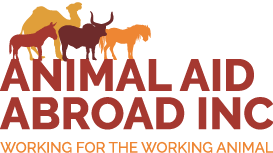Help in Suffering, Camel Rescue Centre, Bassi, India, April update
Thank you so much for making a difference to 568 camels this month and 140 other animals at the Camel Rescue Centre.
Our work is only made possible because of your continuous compassionate support. Your generous contributions allow the animals to receive medical care like that described below when they otherwise may be neglected, potentially saving them from death.
Case 1
Accidents are never predictable; this story is a clear example. Harinarayan Meena is a camel owner who works in the Bagaria village. After completing his work, he tied his camel to provide rest. He kept food and water in front of him around 5 p.m. in the evening.
The weather was very pleasant, cool, and cloudy, and everything was fine until the winds slowly converted into a sand storm. Sand storms are not uncommon here in Rajasthan.
The storm became so powerful that one tin shade flew from somewhere and hit the poor camel in the back, injuring it so deeply. The wound was at least 6 inches deep, so profuse bleeding started.
The owner was so afraid that his mind went blank for some time. When he was ready, he called our shelter, Camel Rescue Centre in Bassi, for help.
Dr Jitendar and the team reached the deep wound and sutured it under anaesthesia. Painkillers and antibiotics were also given. The owner and his family members were so happy with the help they received.
Case-2
One day, while we were standing at Kanota, a person named Tulsi Ram came to us for treatment of mild indigestion. He was given some oral medicines to improve his digestion.
Then he told us that his camel had become partially blind with one eye because the eye got injured by a thorn.
He was right, as his camel had corneal opacity and was full of tears. The camel received treatment of sub-conjunctival injections. Other oral medications and eye drops were also given. The owner thanked our team for their efforts.
Case from daily clinics/ monthly camp
In March, we saw many working animals suffering from different ailments, including horses, goats, dogs, and cows. Some came for deworming and vaccination.
561 camels treated
68 dewormed
12 plastic nose pegs replaced
Nine camel cart reflectors fitted
9 emergencies attended
The Monthly Animal Camp treated 140 animals, including 98 goats, 24 dogs, and 18 buffalo or cattle.
Types of treatment
293 were provided with skin therapy, 68 worming treatment and 76 wound care.
Mobile clinic outreach sessions
16 mobile clinic outreach sessions were run
Thank you so much again for your contributions, which allow Dr. Jitendar to continue attending to animals and providing them with the basic care they need.




